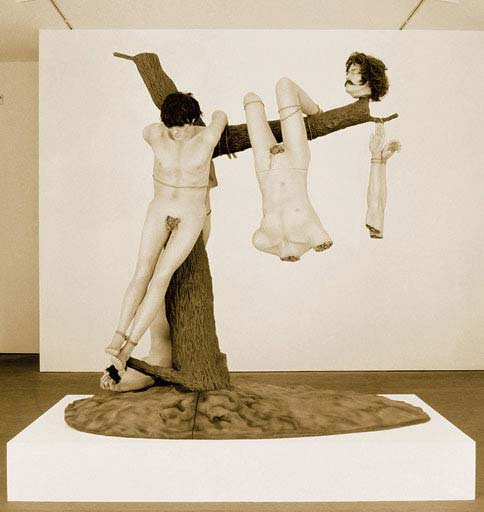
The average American, according to the Clean Air Council, creates 4.6 pounds of trash per day. Much of the trash is non-biodegradable, meaning that it will accumulate, and not necessarily where we’d like it to, if left unchecked.
Californians Against Waste estimates that Americans consume some 84 billion plastic bags a year (the product of roughly 12 million barrels of oil)—many of which, along with many other forms of terrestrial waste, are collecting in an area in the northern Pacific Ocean known as the Eastern Garbage Patch, a floating mass now more than twice the size of Texas.
The mandate of consumerism requires a certain amnesia about what we waste: It encourages us to forget the old and buy the new. Confronting the physical reality of our waste, however, might force a reexamination of our relationship to rampant consumerism.
The sudden interest in found-object art at the recent exhibitions seemed to suggest that the art world was prepared to encourage precisely that sort of reexamination —or so I thought before I actually attended them. (…)
What, however, is one to make of Richard Prince’s pieces, around the corner from Arman’s? The photographs are of Marlboro ads, carefully cropped to remove any ad copy. Prince argues that the iconic Marlboro cowboy, when removed from its original advertising context, encapsulates a certain segment of the American mythos. Perhaps, but the images never are removed from their advertising context—Marlboro’s images are enough of a cultural mainstay that we’re perfectly capable of identifying them without the Marlboro logo. The brand is far stronger than Prince’s effort at artistic dislocation. The primary effect of Prince’s appropriation, rather than rescuing our detritus from obscurity, is merely to extend the reach of advertising into the gallery and the museum. One can hardly claim this is a radical political act, certainly not one that runs counter to consumerism.
{ Pop Matters | Continue reading }
somehow related { Damien Hirst, Appropriation | Wikipedia }
painting { Zhong Biao, Dark Lens, 2002 }
art, horror, ideas | March 3rd, 2010 6:05 pm

Where will the next food crisis strike and how to face it? (…)
Satellite observation is the key instrument that will allow to double in 2010 the number of countries monitored in real time for detecting first indications of adverse agricultural outcomes. (…)
According to the Food and Agriculture Organization, more than 1 billion people go to bed each night with an empty stomach.
{ EurekAlert | Continue reading }
related { Premier Foods declares war on own-label goods. }
food, drinks, restaurants, horror | February 25th, 2010 8:46 pm

Six months is all it took to flip Europe’s climate from warm and sunny into the last ice age, researchers have found.
They have discovered that the northern hemisphere was plunged into a big freeze 12,800 years ago by a sudden slowdown of the Gulf Stream that allowed ice to spread hundreds of miles southwards from the Arctic.
Previous research had suggested the change might have taken place over a longer period — perhaps about 10 years.
The new description, reminiscent of the Hollywood blockbuster The Day After Tomorrow, emerged from one of the most painstaking studies of past climate changes yet attempted.
{ Times | Continue reading }
climate, horror, science | January 28th, 2010 5:25 pm

Once again, I hear the siren song of Toxoplasma, the parasite that dwells in the brains of 50 million Americans.
Toxoplasma gondii is an extraordinary creature. (…) This single-celled organism has a life cycle that takes it from cats to other mammals and birds and back to cats again. Studies have shown that the parasite can alter the behavior of rats, robbing them of their normal fear of cats–and presumably making it easier for the parasites to get into their next host.
Toxoplasma is astonishingly successful, able to live in thousands of species, including us. Billions of people are infected with Toxoplasma, which they pick up from the soil or from contaminated meat or water. In most people it remains dormant, but even in this quiet state it may also have affect human behavior. Some scientists have linked Toxoplasma to schizophrenia, while others have found personality differences between people with Toxoplasma and those who are Toxo-free. It’s possible that it uses its prey-altering strategy on our brains, too.
All well and good. But now Toxplasma is going big time. Today the Proceedings of the Royal Society of London is publishing a paper called, “Can the common brain parasite, Toxoplasma gondii, influence human culture?”
The paper’s answer? Quite possibly yes.
{ Carl Zimmer/ScienceBlogs | Continue reading | Thanks Teaflax! }
horror, science | December 16th, 2009 12:42 pm

A shrunken head is a human head that has been prepared for ritual use or trade.
Most known shrunken heads were manufactured either by indigenous peoples in Melanesia and the Amazon Basin, or by European or Euro-Americans attempting to recreate the practice. In Amazonia, the only people known to have shrunk human heads are the Shuar, Achuar, Huambisa and Aguaruna, collectively classified as the Jivaroan peoples of Ecuador and Peru. Among the Shuar, a shrunken head is known as a tsantsa.
{ Wikipedia | Continue reading }
By the end of the nineteenth century, little was still known about the Jivaro Indian clans in South America, except for their macabre practices of taking the heads of their enemies. This practice intrigued travelers and collectors and compelled them to visit these tribes to satisfy their curiosity.
The visits of the white man helped revolutionize the Jivaro’s methods of warfare, as they began trading firearms and ammunition for shrunken human heads. (…)
In the 1930s heads were made to order and sold for approximately $25.00.
{ The History of the Shuar | Continue reading | via Cracked }
economics, horror | November 7th, 2009 3:07 pm

{ Goya, Plate 39 from The Disasters of War, 1810-1820 }

{ Jake and Dinos Chapman, Great Deeds Against the Dead, 1994 }
The Chapman brothers, fresh out of the Royal College of Art, had become obsessed with Goya’s gory ouvre - to the point, as Jake Chapman told me in a phone interview, that they later even considered changing their surname to Goya. They were especially haunted by the famous series of etchings known as “The Disasters of War”, in which Goya portrayed the atrocities he had witnessed in the Peninsular War between Spain and France (1808-1814) with a visceral horror. (…)
In 1994, they re-created plate 39 of “The Disasters of War - Great Feat! With Dead Men!” - on a larger scale, using nylon-wigged mannequins. Great Deeds Against the Dead (1994), which was their contribution to the legendary ‘Sensation’ exhibition at the Royal Academy, depicts three naked male bodies bound to a tree; blood dribbles from the crotches of these shop dummies where their genitalia would have been, if they’d ever had them. One victim’s arm dangles by its fingers from the makeshift gallows alongside the carcass of his torso, the severed head skewered on a branch.
{ Christopher Turner, editor at Cabinet magazine | Tate | Continue reading }



{ Jake and Dinos Chapman, Sex, 2003 }
With their bronze sculptures under the title “Sex” (2003), the Chapman brothers make a jump in time. They show the decomposed corpses from “Great Deeds Against the Dead” (1994). The bodies are swarming with flies, maggots, worms, and all sorts of creatures which have picked their bones clean. At first glance, everything seems naturalistic. It isn’t until one examines the work more closely and talks to the artists that one realizes the flies and worms were originally cheap plastic reproductions from toy stores and novelty shops. These were cast in bronze and hand-painted by the artists.
{ Absolute Arts | Continue reading | Art Net }

{ Jake and Dinos Chapman, Death, 2003 }
art, horror | October 30th, 2009 9:00 am












